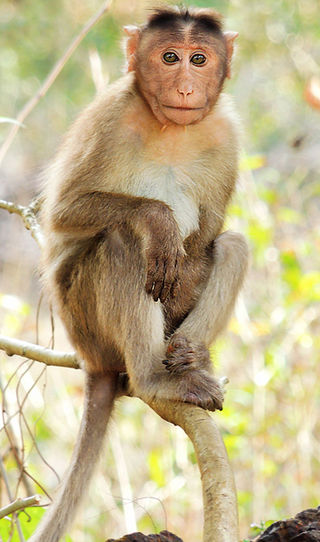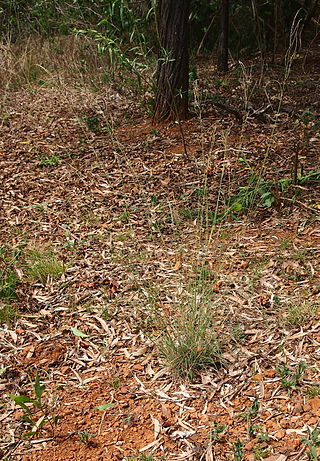
The macaques constitute a genus (Macaca) of gregarious Old World monkeys of the subfamily Cercopithecinae. The 23 species of macaques inhabit ranges throughout Asia, North Africa, and Europe. Macaques are principally frugivorous, although their diet also includes seeds, leaves, flowers, and tree bark. Some species such as the long-tailed macaque will supplement their diets with small amounts of meat from shellfish, insects, and small mammals. On average, a southern pig-tailed macaque in Malaysia eats about 70 large rats each year. All macaque social groups are arranged around dominant matriarchs.

The crab-eating macaque, also known as the long-tailed macaque and referred to as the cynomolgus monkey in laboratories, is a cercopithecine primate native to Southeast Asia. A species of macaque, the crab-eating macaque has a long history alongside humans. The species has been alternately seen as an agricultural pest, a sacred animal, and, more recently, the subject of medical experiments.

The Nicobar long-tailed macaque is a subspecies of the crab-eating macaque, endemic to the Nicobar Islands in the Bay of Bengal. This primate is found on three of the Nicobar Islands—Great Nicobar, Little Nicobar and Katchal—in biome regions consisting of tropical and subtropical moist broadleaf forests.
Wettinia fascicularis is a species of flowering plant in the family Arecaceae. It is found in Colombia and Ecuador.

Asclepias fascicularis is a species of milkweed known by the common names narrowleaf milkweed and Mexican whorled milkweed. It is a perennial herb that grows in a variety of habitats.

The Philippine long-tailed macaque is a subspecies of the crab-eating macaque, known in various Philippine languages as matching/matsing or the more general term unggoy ("monkey"). It is endemic to the Philippine forests and woodlands, but especially in the mangrove forests of western central Philippines— particularly in Palawan, the Visayas, and Mindanao. The names M. f. philippinensis and M. f. philippinenesis have also been used, but arise from orthographical error.

Leptochloa is a widespread genus of Asian, African, Australian, and American plants in the grass family.
Trachelostenus is a genus of darkling beetles in the family Tenebrionidae. It is native to the Valdivian forests of Chile, and has at least two species, T. inaequalis (Solier) and T. fascicularis (Philipp). It was historically considered the only member of the family Trachelostenidae, but a 2015 study sunk the genus into the tenebrionid subfamily Tenebrioninae.

Dosima fascicularis, the buoy barnacle, is "the most specialised pleustonic goose barnacle" species. It hangs downwards from the water surface, held up by a float of its own construction, and is carried along by ocean currents.

Darwinia fascicularis is shrub in the myrtle family and is endemic to areas near Sydney. A small shrub with aromatic foliage and white flowers, turning red as they mature. Nectar feeding birds are attracted to its flowers as a food source.

Capparis fascicularis, the zigzag caper-bush, is a plant in the Capparaceae family and is native to Africa.

Nephtheis fascicularis, commonly called the lollipop tunicate, lollipop coral, or blue palm coral, is a species of tunicate that is native to the shallow reefs of Indonesia. It is the only species in its genus Nephtheis. They are not photosynthetic, and live on plankton and small organic particles obtained from the water currents. The branched stems are formed by tiny polyps called zooids.

Trichostetha fascicularis is a large, metallic-green beetle found in South Africa.

Galaxea is a genus of colonial stony corals in the family Euphylliidae. Common names include crystal, galaxy, starburst and tooth coral. They are abundant on reefs in the Indo-Pacific region and the Red Sea. They are found in water less than 20 metres (66 ft) deep and favour turbid sites. They are sometimes kept in reef aquaria.

Galaxea fascicularis is a species of colonial stony coral in the family Euphylliidae, commonly known as octopus coral, fluorescence grass coral, galaxy coral among various vernacular names.

Trichostetha is a genus of beetle in the scarab beetle family. It is endemic to southern Africa, and its species most commonly occur in mountainous terrain. The genus includes several species that have only recently been described, as well as many species lacking a description of any of the larval stages. Except for T. fascicularis and its subspecies, the species comprising Trichostetha have small ranges of distribution, frequently in the Cape Floral Region of South Africa. The genus is believed to be related to Odontorrhina.
Gasponia is a genus of longhorn beetles of the subfamily Lamiinae.
Gasponia gaurani is a species of beetle in the family Cerambycidae. It was described by Fairmaire in 1892. It is known from Ethiopia, Djibouti, Somalia, Kenya, and Tanzania.
Gasponia penicillata is a species of beetle in the family Cerambycidae. It was described by Gahan in 1904. It is known from Malawi, Zambia, Namibia, South Africa, Mozambique, and Zimbabwe.

Ranunculus fascicularis, commonly called early buttercup, is a species of flowering plant in the buttercup family (Ranunculaceae). It is native to the eastern North America, where it is found in Canada and the United States. It is generally widespread in eastern North America, although its populations become sporadic in areas east of the Appalachian Mountains and south of New England. Its natural habitat is in dry areas with sparse vegetation, such as rocky or sandy bluffs, prairies, and savannas.














